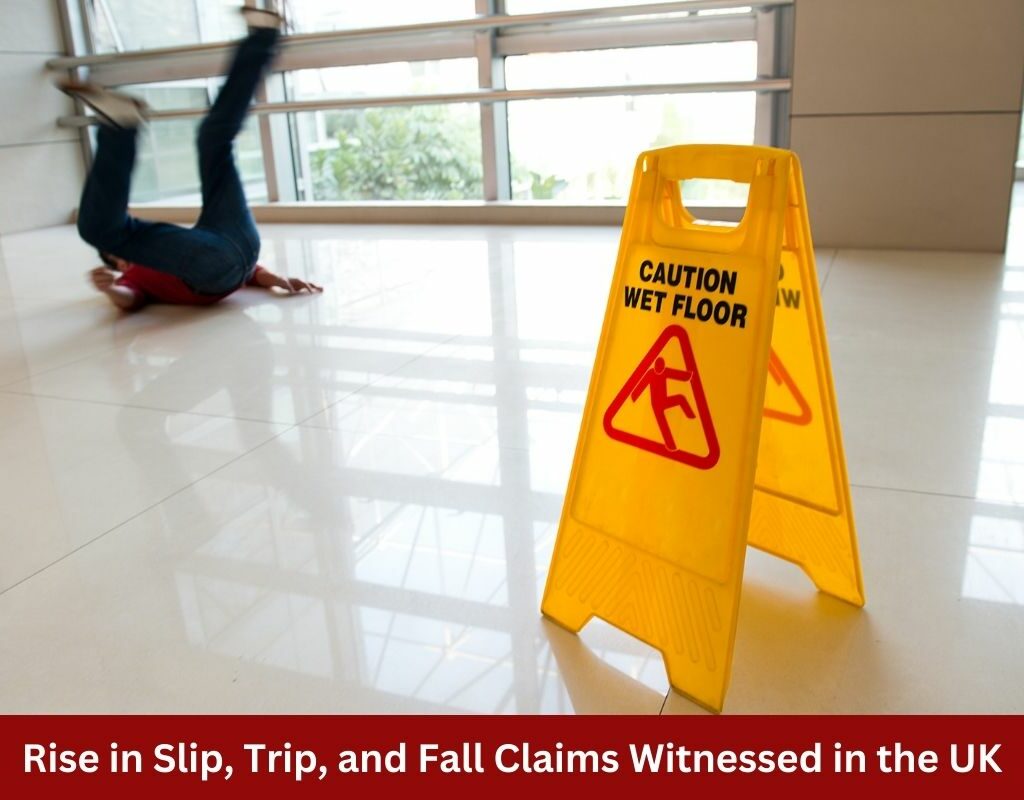The United Kingdom has recently seen a notable surge in the number of personal injury claims related to slip, trip, and fall incidents.
The increase has sparked discussions amongst legal, insurance, and safety circles and brought attention to the importance of maintaining safe public and workplace environments.
The Current Trend
Recent data suggests a significant uptick in the number of personal injury claims due to slip trip and fall accidents, with many such incidents occurring in both public places and workplaces. While some have attributed this increase to growing public awareness about legal rights and recourse in such situations, others suggest that the rise points to broader public safety and risk management issues.
Insurance Industry Impact
The increase in slip trip and fall claims is also making waves in the insurance industry. Insurance providers have registered a spike in such claims leading to a higher outlay in terms of settlements and payouts. This, in turn, might impact the premium rates for public liability insurance if the trend continues upward.
Many insurers are advocating for better risk management practices among their policyholders to mitigate such incidents. They are recommending proactive measures such as regular safety audits, prompt repair and maintenance, and proper signage to warn of potential hazards.
The Legal Perspective
Legal professionals are witnessing a sharp rise in the number of people seeking legal advice and representation for slip, trip, and fall claims. This uptick can be attributed, in part, to a more informed public that recognizes their right to compensation in the aftermath of an accident that wasn’t their fault. Many law firms have expanded their personal injury departments in response to this surge, and a growing network of support is available for those seeking to file such claims.
However, there is also a note of caution being sounded. Legal professionals remind claimants of the burden of proof that rests with them to establish negligence on the defendant’s part. It must be demonstrated that the party at fault had been negligent in their duty of care, leading to the accident.
Preventative measures: Cutting Back on Slip Trip and Fall cases
- Regular Maintenance: Ensuring that premises, whether they be workplaces or public spaces, are well-maintained and free from hazards that might cause slips, trips, and falls.
- Proper Lighting: Adequate lighting can help avoid accidents, especially in areas that have steps, uneven surfaces, or potential obstacles.
- Signage: Clear signage warning of potential hazards, like wet floors or ongoing construction work, can significantly reduce the risk of accidents.
- Flooring Material: Businesses should consider using non-slip materials for flooring, particularly in areas prone to becoming wet or slippery.
- Safety Training: Employers should provide regular safety training to employees, making them aware of potential hazards in the workplace and teaching them how to avoid accidents.
- Use of Personal Protective Equipment: In certain workplaces, personal protective equipment such as non-slip footwear can significantly reduce the risk of slip, trip, and fall incidents.
- Clearing Clutter: Keeping walkways clear from clutter can prevent tripping hazards. Regular tidying up can significantly reduce the risk of accidents.
- Prompt Reporting of Hazards: Encourage everyone to report potential hazards as soon as they notice them. A quick response can prevent an accident.
Remember, prevention is always better than cure. A conscious effort to maintain safe environments can drastically decrease the number of these unfortunate incidents, leading to safer spaces for all.
The Role of Personal Responsibility
While discussions around slip, trip, and fall claims often focus on the responsibilities of businesses and local authorities, it’s important not to overlook the role of personal responsibility in accident prevention. Individuals also need to exercise caution and heed safety warnings in their surroundings.
Public awareness campaigns about the importance of personal safety can be an effective tool to reduce the occurrence of these accidents. Encouraging individuals to report potential hazards in their environments can also contribute to preventing accidents. After all, accident prevention is a collective responsibility, and everyone has a part to play in creating safer public and workplace environments.
The Workplace Safety Angle
A significant proportion of slip, trip, and fall claims originate from incidents that occur in the workplace. The recent increase in such claims is a reminder of the importance of stringent health and safety measures in work environments.
Employers are encouraged to reassess their workplace safety protocols and ensure they comply with the Health and Safety at Work Act. This involves keeping workplaces free from hazards that might cause slips, trips, and falls, providing appropriate training to staff, and promptly addressing any safety concerns raised by employees.
Public Space and the Role of Local Authorities
Public spaces such as parks, streets, and public buildings are also common settings for slip, trip, and fall accidents. Local authorities have a duty of care to ensure that these environments are safe for public use. This includes maintaining pavements and public walkways, managing public facilities, and ensuring safety during public events.
However, with the rise in accident claims, questions are being raised about the effectiveness of these safety measures. The growing number of claims highlights a potential gap in the management and upkeep of public spaces that local authorities need to address. They must reassess their risk management strategies and implement comprehensive safety audits to identify and rectify potential hazards proactively.
In The End…
While the rise in slip, trip, and fall claims in the UK reflects increased public awareness about legal rights, it also underscores the ongoing need for rigorous safety practices. Individuals, businesses, and public entities must work together to ensure environments are kept safe to mitigate such accidents.
On the flip side, this trend provides an opportunity for insurers and legal service providers to better serve their clients by guiding them through the claim process or offering strategies to prevent such incidents. Amid the complex interplay of legal, insurance, and safety concerns, the central message remains clear: safety should always be paramount.

